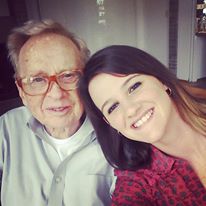Brainstorming for this project proved to be extremely difficult for me. I felt constrained and unimaginative, creating simple 3D geometric shapes. I tried to think “out of the box” (no pun intended) but I ended up with a bunch of cubes. I decided instead of forcing myself to think of something totally new, I would just roll with what I had and try to make a cube as interesting as possible. Soon the idea hatched to make a cube inside a cube seeming to float in mid-air. So I sketched a plan and went to work.
I wasn’t prepared for the amount of math I had set myself up for. Because I was making each edge of the square its own 3 dimensional rectangle, I had to make some edges shorter than others. After measuring and counting how many sizes of each side I would need for each square, I got to cutting.
Even after checking and rechecking my math, I still managed to write down the wrong number. Instead of making eight 36” boxes to fit with the four 48” boxes to create the big outer box, I accidently made eight 24” boxes. This resulted in a rectangle shape instead of the perfect cube I was going for. Instead of throwing the eight boxes out, I decided to just reduce the 48” boxes down to 36” so the 24” boxes would be the right size to complete the cube.
 The next problem I faced was the paper tape I had bought. It was strong enough to bind the smaller box rectangles together, but it was not binding the individual rectangles together to create the entire box. I ended up using almost an entire roll of masking tape to support the box, then covered it in paper tape. Because I am spray painting it black, I will need to cover every edge and open area with tape.
The next problem I faced was the paper tape I had bought. It was strong enough to bind the smaller box rectangles together, but it was not binding the individual rectangles together to create the entire box. I ended up using almost an entire roll of masking tape to support the box, then covered it in paper tape. Because I am spray painting it black, I will need to cover every edge and open area with tape.
For my last few steps, I need to cover both cubes with the spray paint as well as hang the smaller cube within the bigger cube using clear fishing line I bought.
My original idea was to hang this entire piece from the ceiling to give the whole thing a really weightless feel to go along with the floating cube on the inside, but my plan B is to find a nice, elevated spot outside where people can get a good view of the floating cube inside of it.
My piece is titled Boundaries. According to the Merriam-Webster online dictionary, boundary is defined by the following:
bound·ary
noun \ˈbau̇n-d(ə-)rē\
: something (such as a river, a fence, or an imaginary line) that shows where an area ends and another area begins
: a point or limit that indicates where two things become different
boundaries : unofficial rules about what should not be done : limits that define acceptable behavior
I feel this piece applies to the definitions above because of the material and context within the design. Boundaries have a lot to do with area, as does planes and the use of flat cardboard. Cubes have a very defiant area, but is confused in this piece because of the inner cube. Is this piece all one cube with implied lines, or are they separate cubes? “Unofficial rules about what should and should not be done” can be applied to the concept of physics within the boundaries of the piece. It is not normal or typical behavior for something to appear to defy gravity, therefore it exceeds the boundaries of acceptable behavior.
“Boundaries”






 Cincinnati Contemporary Art Museum
Cincinnati Contemporary Art Museum




























































